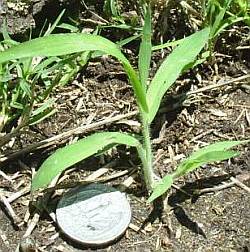Baby crab grass. No other grass looks or grows like it.
Crabgrass is already starting to
sprout as Heron’s Bill sets seed; it’s been a warm spring. Now is the time to most easily get rid of it. It is an annual relative of Bermuda grass and
has the same kind of flower stalks, with four branches.
Young Crabrass, flat spreading. Credit: extension.entm.purdue.edu
Young crab grass, upright and easily pullable. Credit: garden-counselor-lawn-care.com
Crabgrass breaks all the rules of
annual weeds. Most annuals are easiest
to pull when flowering, because they have shrunk their roots in order to grow
their flower stalks. Crab grass is
hardest to pull then, at least if it is well watered; it puts down strong, wiry
roots from its stem joints as it flowers, and becomes even more firmly rooted.
Crab grass seed stalk. Note the resemblance to Bermuda grass. Credit: garden-counselor-lawn-care.com
Other weeds are more easily pulled
from damp soil. Crabgrass puts down
deeper, stronger roots when it is growing in damp soil; in dry soil, it makes
little root, living literally on dust and dew.
Right now, it is about an inch high
in bare soil areas with lots of sun.
It’s still waiting to sprout in cooler areas. Its seeds are fine; they don’t come up
through mulch, though they will come up on top of it. In areas where it is coming up or where you
know it seeded last year, it is time to mulch or hoe it out.
In lawns, an inch of compost will
stop crab grass and other small seeds from sprouting, smother small weeds and
moss, and feed the grass. Cut the grass to
one inch, cover with compost, and let the grass grow through it. Keep the grass cut at 2 inches or more to
keep weeds from invading.
On
open soil, it comes up thick, but mulch is easier to spread. Cover it with 2 inches of compost, Walk-on
fir (shredded bark-wood mix) or one inch of 4 x 8 sand (1/4-1/8 inch river
sand). (Avoid fine bark; it kills soil
life.)
Cover it with Walk-on, and your work
is done. In the sand, anything that
sprouts can be cut or pulled below the crown with a hula hoe (aka scuffle hoe
or stirrup hoe) and raked out. You can
use deeper sand, but it feel like walking on a beach. You can also use the hula hoe on young weeds
in bare soil if it is at all loose, but then you have bare soil to track around
and grow the little buggers all summer.
While
it is easiest to mulch it out as or before it sprouts, it can be easily pulled
until it flowers, and even then if the soil is not watered well. Not that dry soil is good; other weeds are a
pain in dry soil, from which they are hard to pull.
You
can also kill it when it is well-rooted, by cutting it below the crown with
pruning scissors. The roots, while wiry,
have no food in them; cut off the plant, and they die in the soil. This also works on puncture vine and star
thistle in dry soil where they do not pull.
Published on Yahoo Voices
Rycke Brown, Natural Gardener 541-955-9040 rycke@gardener.com




No comments:
Post a Comment